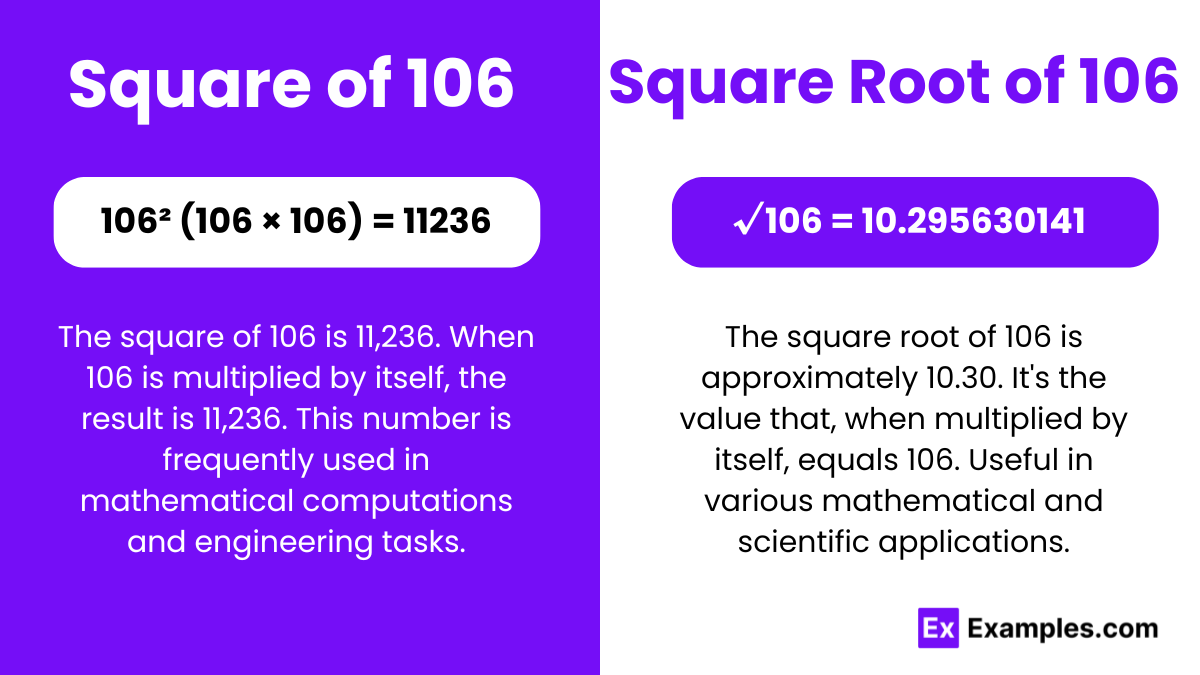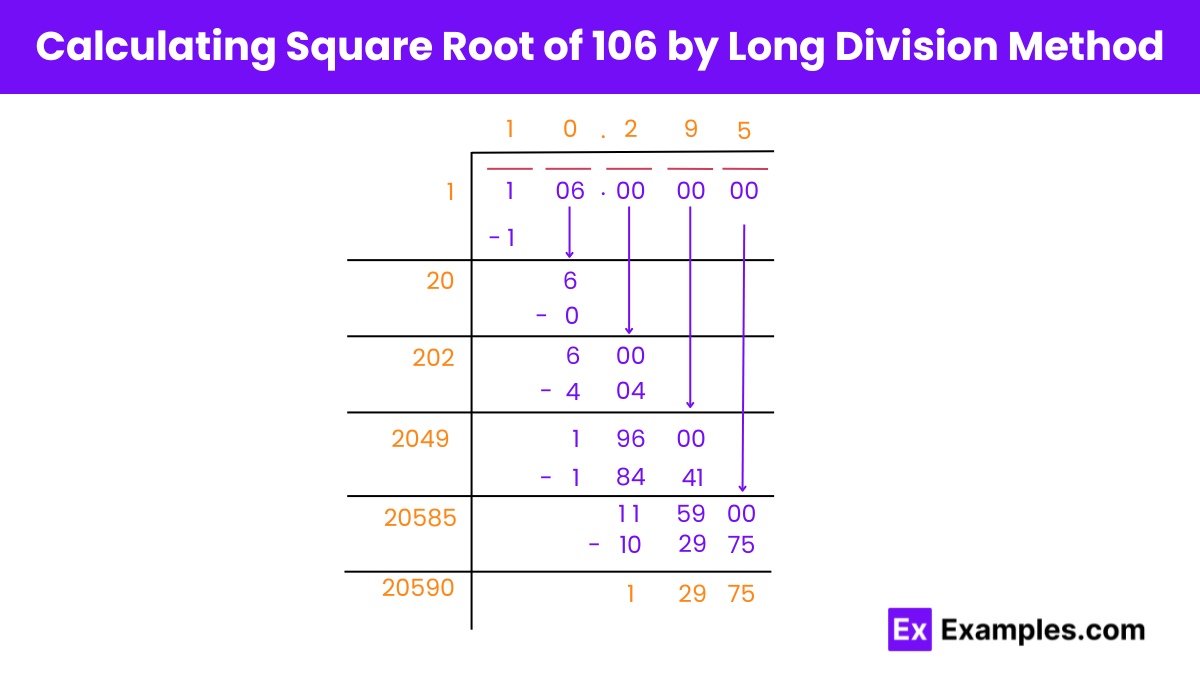What is the square of 106?
11,200
11,236
11,258
11,260


In the domain of mathematics, particularly within algebra, squares and square roots are foundational. Squaring, demonstrated by multiplying a number like 106 by itself to obtain 11236, is fundamental. This operation lays the groundwork for exploring properties of rational and irrational numbers. Understanding these concepts enriches comprehension of mathematical relationships and patterns, vital in algebraic studies and beyond. In the realm of mathematics, squares and square roots are pivotal. Squaring, exemplified by multiplying 106 by itself to yield 11236, serves as a cornerstone. This process aids in exploring the properties of both rational and irrational numbers, deepening comprehension of mathematical relationships and patterns within algebraic studies and beyond.
106² (106 × 106) = 11236
A square number, such as 106, results from multiplying an integer by itself. The square of 106 equals 11,236. This fundamental operation illustrates algebraic principles, showcasing the inherent properties of rational and irrational numbers, enriching understanding of mathematical relationships and patterns within algebraic studies.
√106 = 10.295630140987
Or
√106 = 10.295 Upto 3 decimals
The square root of 576, a square number, is 24. Understanding square roots involves finding the number that, when multiplied by itself, equals 576. Mastery of square roots unveils fundamental mathematical concepts, essential for exploring algebraic relationships and patterns within the realm of mathematics.
Square Root of 106:10.295630140987
Radical Form: √106
The square root of 23 is an irrational number
The square root of 106 is irrational. It cannot be expressed as a fraction of two integers, and its decimal representation continues infinitely without repeating. Thus, it falls under the category of irrational numbers.
Rational Numbers: Rational numbers are expressed as fractions of two integers, like 3/4 or -5/2.
Irrational Numbers: Irrational numbers cannot be written as fractions of integers. Their decimal expansions neither terminate nor repeat. For instance, the square root of 2 (√2) ≈ 1.41421356… is irrational.
There are several methods to find the square root of 106:
Estimation Method: Make an initial guess, then refine it iteratively using approximation techniques like the Newton-Raphson method.
Prime Factorization Method: Express 106 as a product of prime factors, then find the square root of each prime factor.
Long Division Method: Apply long division to iteratively find the digits of the square root.
Calculator: Utilize a calculator with a square root function to directly compute the square root of 106.

Long Division Method for Finding the Square Root of 106
Step 1: Digit Pairing
Pair digits of 106 starting from the right, indicating with a horizontal bar.
Step 2: Initial Quotient
Find a number whose square is less than or equal to the first paired digits (1). Since 1² = 1, use 1 as the initial divisor.
Step 3: Bringing Down
Bring down the next pair of digits (06) and multiply the quotient (1) by 2 to get 2, which is the starting digit of the new divisor.
Step 4: Further Division
Place 0 at the one’s place of the new divisor (20). Multiply 20 by 0 to get 0. The obtained answer is 20, and bring down 00.
Step 5: Iterative Division
Step 6: Continued Division
Repeat the process iteratively until the desired level of accuracy is achieved. Place 9 at the one’s place of the new divisor (2049). Multiply 2049 by 9 to get 18441. Subtract and bring down 00.
Step 7-10: Continued Iteration
Continue the division process, adjusting the divisor and finding the next digit until the desired level of precision is achieved. Repeat until the desired level of accuracy is reached.
Final Result
The result obtained through long division is the square root of 106, approximately 10.2956, rounded to the nearest ten-thousandth.
No, 106 is not a perfect square because it cannot be expressed as the product of an integer multiplied by itself. In other words, there are no integers where the product of the integer with itself equals 106.
The square of 106 is a positive integer, while the square root of 106 is a positive irrational number.
You can verify your calculation by squaring the square root value obtained. If the result is 106, then your calculation is correct.
Understanding squares and square roots is essential in various fields such as engineering, physics, computer science, and finance for tasks like calculating areas, distances, and determining quantities.
The decimal representation of the square root of 106 is non-repeating and non-terminating, indicating no discernible pattern in its digits.
Understanding squares and square roots serves as a foundational step in algebra, helping to comprehend concepts like equations, inequalities, and polynomial functions.
Text prompt
Add Tone
10 Examples of Public speaking
20 Examples of Gas lighting
What is the square of 106?
11,200
11,236
11,258
11,260
Which of the following is closest to the square root of 106?
10
10.3
10.6
11
If you square the number 10.3, which result is closest to 106?
104.09
106.09
108.9
110.5
Which number squared equals 106?
10
10.1
10.2
10.3
What is the result of squaring the number 106?
11,236
11,316
11,196
11,076
Find the square root of 106 to the nearest tenth.
10.1
10.2
10.3
10.4
Which value is the closest estimate to the square of 10.2?
104.04
106.04
108.04
110.04
What is the closest integer to the square root of 106?
9
10
11
12
Which of the following is the correct square of 10.5?
110.25
108.25
105.25
102.25
Calculate the square root of 106 and round it to the nearest whole number.
10
11
13
15
Before you leave, take our quick quiz to enhance your learning!

